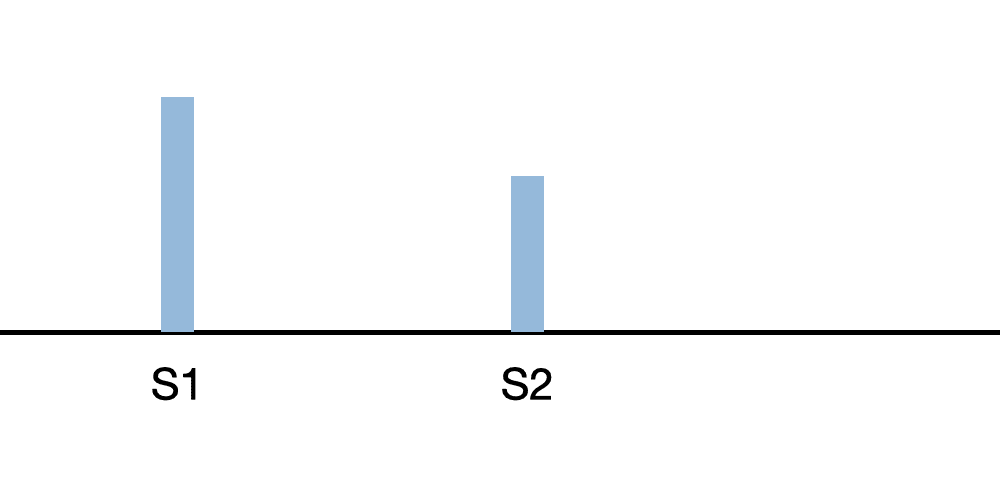
Introduction
This normal heart sounds module includes seven lessons covering essential normal heart sounds. We provide a textual description, audio recording, dynamic waveform video, and a cardiac animation for each lesson. Optionally, the user can take a quiz to measure comprehension and listening skills. Users who have selected our Essentials or Advanced plans can print achievement certificates and view their progress and scores using our personalized dashboard.
Overview

The closure of the mitral and tricuspid valves creates the first heart sound. The mitral valve usually closes first, immediately followed by the tricuspid valve. Closure of the aortic and pulmonic valves creates the second heart sound.
The stethoscope's diaphragm is positioned at the apex (mitral valve area). Usually, the first heart sound is somewhat louder than the second heart sound when auscultating at the apex. Sound intensity will vary with the chestpiece's position and the patient's anatomy.
In addition to sound intensity, the first heart sound (S1) can be identified by its timing. At moderate heartbeat rates, the first heart sound follows the longer pause.
Start Normal Heart Sounds Course
Normal Heart Sounds Lessons
Loud First Heart Sound
The first heart sound is usually slightly louder than the second when auscultating at the mitral valve (apex).
The first heart sound is much louder than the second heart sound in this case. A thickened but still movable mitral valve is generating this particular sound. Look at the anatomy video to see the thickened mitral valve leaflets.
Loud first heart sounds can also be observed in patients with thin chests.
Minimally Split First Heart Sound
Commonly, the first heart sound consists of two sounds separated by a very small interval (20-30 milliseconds). The mitral sound (M1) typically occurs before the tricuspid sound (T1). T1 and S1 splitting can be best heard at the tricuspid location. If M1 and T1 are separately distinguished, this is called an S1 split. S1 splitting is common in children. An S1 split can be associated with EKG-related abnormalities such as right bundle branch block, premature ventricular contractions, or ventricular tachycardia in adults.
A minimally split first heart sound is a normal variation of the first heart sound.
Minimally Split First Heart Sound Lesson
Physiologically Split Second Heart Sound
Timing between the aortic and pulmonic components of the second heart sound varies during normal respiration. This causes splitting of the second heart sound.
Maximum splitting occurs at peak inspiration. In this recording, the S2 split is 60 milliseconds at peak inspiration with no splitting at peak expiration.
Physiologically Split Second Heart Lesson
Physiologic Third Heart Sound
The third heart sound (S3) can be heard early in diastole. Along with the first and second heart sounds, this extra sound creates a gallop cadence and sounds like "Kentucky." The second heart sound is unsplit in this recording so that S3 is easier to hear.
Use the stethoscope bell at the apex because the third heart sound has a very-low frequency. If the patient lies on her left side, S3 will usually be louder.
The third heart sound is normal in children and young adults. Women lose S3 in their thirties, while men lose S3 in their twenties. After these ages, S3 can indicate heart disease, except for adults active in sports or fitness.
Physiologic Third Heart Sound Lesson
Innocent Murmur
An innocent murmur is seen in children and in adults with pregnancy, hyperthyroidism, exercise, and anemia conditions.
The murmur is heard in early systole. An innocent murmur is of short duration and has a frequency range of 120Hz to 250Hz. It is best auscultated in the pulmonic area and increases in intensity with inspiration. It can be heard with either the bell or diaphragm.
In this recording S1 and S2 are normal. Diastole is silent. The short duration and mid-range frequency characterize an innocent murmur.
Fast Heart Rate with Exercise
Exercise increases both the heart rate and the intensity of the first heart sound. Systole and diastole have equal duration with a heart rate of 120 BPM.
Conditions such as fever, stress, and hyperthyroidism can also increase the intensity of the first heart sound.
Use the stethoscope's diaphragm to auscultate these sounds.
Fast Heart Rate with Exercise Lesson
Course Quiz
After completing all lessons in a course, a quiz becomes available. If the user successfully completes a quiz, results are saved to the user's dashboard and a certificate can be printed.
Reference Guide
For subscribers, we provide a comprehensive heart sounds and murmurs reference guide. For each abnormality, one or more sound recordings are available along with text, phonocardiogram and cardiac animation.Course Completion
Registered users can earn a certificate of achievement for this module by reading all content and then earning a passing score on this module's quiz.
Completed modules and related scores can be viewed on the dashboard.
Authors and Sources
Authors and Reviewers
-
Heart sounds by Dr. Jonathan Keroes, MD and David Lieberman, Developer, Virtual Cardiac Patient.
- Reviewed by Dr. Barbara Erickson, PhD, RN, CCRN.
-
Last Update: 11/9/2021
Sources
-
Heart Sounds and Murmurs Across the Lifespan (with CD)
Dr Barbara Ann Erickson
Publisher: Mosby
ISBN-10: 0323020453; ISBN-13: 978-0323020459 -
Heart Sounds and Murmurs: A Practical Guide with Audio CD-ROM 3rd Edition
Elsevier-Health Sciences Division
Barbara A. Erickson, PhD, RN, CCRN - How to measure blood pressure using a manual monitor
Mayo Foundation for Medical Education and Research (MFMER) -
Heart and Lung Sounds Reference Guide
PracticalClinicalSkills.com -
Manual Blood Pressure Measurement
Vital Sign Measurement Across the Lifespan